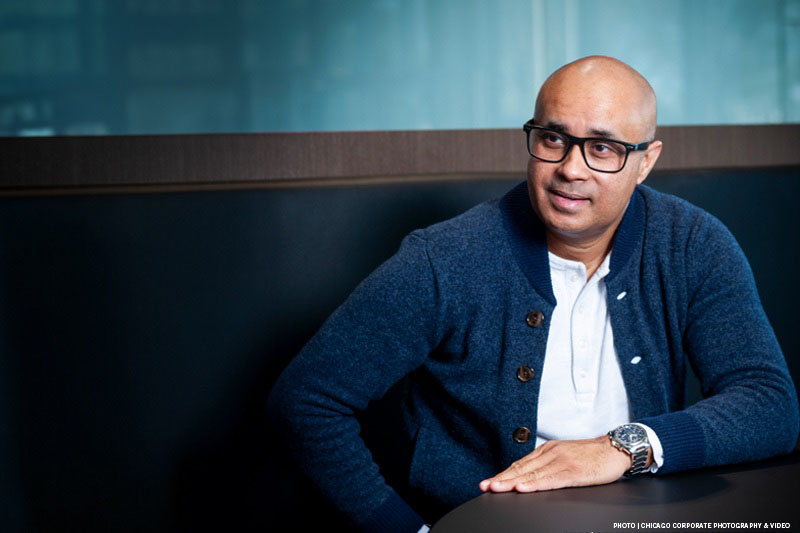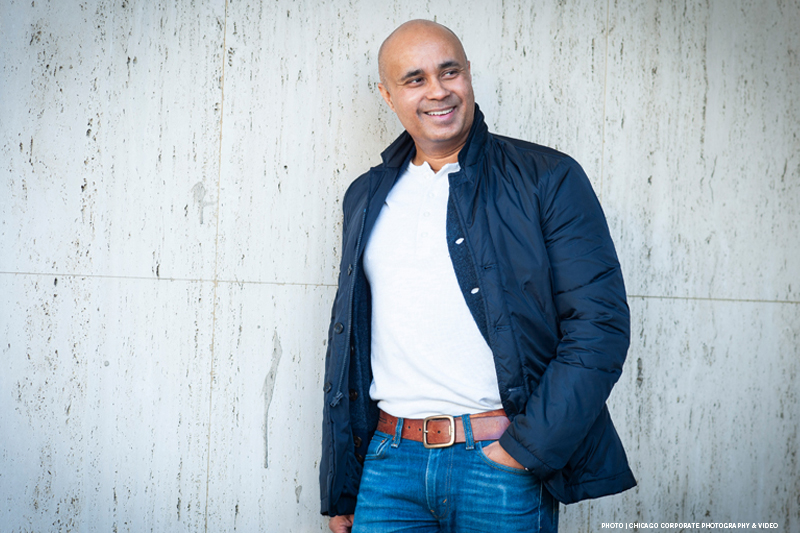Talent Development Leader
Learning Is Our Product
Although Shahid Najmi entered the profession via an indirect path, his solution- and product-oriented mindset is just what Tenneco’s L&D team needed.
Mon Jan 22 2024

Although Shahid Najmi entered the profession via an indirect path, his solution- and product-oriented mindset is just what Tenneco’s L&D team needed.
Talent development leaders rarely take a straight route into the field, but few have followed a path as winding as Shahid Najmi, executive director of enterprise L&D for Tenneco, a global designer, manufacturer, and marketer of original parts and aftermarket equipment for the automotive industry.
With a career journey that started out by studying to become a doctor, then winding through various stints in advertising and sales, graphic and media design, learning technology, 3D game and application development, consulting, filmmaking, and management roles at a startup, Najmi shares that many people thought he was confused or fickle. But he contends that he was “insanely curious.” More importantly, he was collecting valuable skills.
“I dive fully into any task and learn everything I can. So, when I would master one thing, I would be given the responsibility of five new things, which gave me five new learning goals—from being the best in sales, to earning my Six Sigma Green Belt, to acquiring UX \[user experience\] certification, to attaining an MBA,” he explains.
“I just kept moving and learning”—which has uniquely positioned Najmi to take on his TD leadership role at Tenneco, which comprises nearly 200 manufacturing sites, 38 global engineering and technical centers, and 29 aftermarket distribution centers across Europe, Asia, and the Americas.
When Najmi joined the company six years ago, it was in the process of centralizing the TD function. Although a global organization, teams were disparate and “a lot of our learning was localized within the region and within the individual plants,” he says. “But whether you develop somebody in Asia or North America, they should learn the same principles that align with Tenneco’s overall values and people philosophies.”
According to Najmi, designing and developing a program for the central organization but deploying it on a regional basis enables the organization's learning developers and facilitators to “add a local accent to learning but always speak the same values, same culture from a company standpoint.”
Taking a product-based approach
Najmi believes learning professionals should approach the development and delivery of learning solutions the same as developing any other type of consumer product.
He asserts that organizations often consider training as a tool that employees have no choice about consuming. “The reality is it’s a product and, if it has poor user experience, it will not sell or work for the organization. You want people to buy it, paying for it with their time and attention.”
Because of his work experience, Najmi typically sees problems and challenges as UX problems first. In fact, he prefers to refer to learners as users.
“I can give you any sort of learning solution, but if you don't know how to use it or it's not easy for you to access or consume, it does not matter how beautiful or expensive it appears—you will not use it.” he states.
When applying his product-based, user-first approach to designing and delivering employee learning solutions, Najmi contends that the TD team should think: “Here's the user of my product, and here's the outcome that the organization is looking for. How do I get the user to start behaving in a specific way that will create those results? But we also need to cater to what's on users' minds. What problem are users trying to solve?”
Najmi advises TD professionals to embrace the principles of design thinking and become experts at collecting data and analyzing trends to better understand the real issues. “If you're trying to solve a user problem, you have to look for where and how they're struggling. For example, are they trying to work on a specific machine or process? Is the user new to the job or do they have some experience? Do I have any data about that machine or the job? Who in the organization should I talk to to learn more about these variables?”
What’s more, according to Najmi, the notion that “learning has a captive audience is over. Learning must be engaging.” He adds that when the design takes a products approach, you can create solutions with the environment and user profile in mind.
“We can add features based on what the user needs not only today but also in the future. L&D becomes more sustainable and scalable,” he says.
TD functions, therefore, must embrace their problems as well as their products.
“I don't just love my products; I love my problems,” Najmi declares. “I'm always asking our users, ‘What did you not like about this? What did we miss? What can we do better?’ When you have a product, people can give you feedback, so you can polish and perfect it. In the end, talent development’s masterpiece is not only the product; it is our process.”

Case in point
In 2019, Tenneco acquired Federal Mogul, another global supplier of automotive parts. Leadership anticipated that the transition would affect frontline leaders the most and asked the TD function to deliver a leadership development program.
“Irrespective of where you sit in the organization, what products you make, or who you interact with, \[TD\] has to make sure that our people development is strong,” Najmi says.
Specifically, the goal was to create a weeklong program and travel from plant to plant to deliver learning to 10 to 12 participants at a time. But Najmi admits to being uneasy about how the initiative would work.
“I knew I needed to talk directly to the people actually on the front lines about their different needs and challenges.” Determined to meet with the employees despite the pandemic, Najmi conducted individual calls with them, their managers, and HR team members. Through those discussions, it became clear that frontline managers wanted to learn, but they couldn’t foresee leaving the production line for two or three days of training.
“Their productivity is their impact, and when they get behind schedule, problems can surface, and production can slow. It snowballs quickly,” Najmi notes.
Additionally, he heard from the frontline leaders and their managers that they were unconvinced about the usefulness of the training they had received in the past, in part because it was disconnected to their work.
“They would say, ‘I get the content. But I'm transported to a different world, and when I come back to the plant floor and try to apply what I learned, it does not always make sense.’ They struggled with going away for learning, and then returning to the plant. It was too easy for them to return to old ways.”
After reviewing his findings and conducting design thinking-type card-sorting exercises with insights and data points, Najmi realized that frontline leaders required a program that was akin to moment-of-need learning and kept them as close to their work environments as possible.
“We started designing the program, keeping the frontline leader—the user—in the center of the page. We knew that they were looking for context. They were looking for a story. They were looking for speed. And they were looking for something where they didn’t have to travel,” he states.
Enter The On-Ramp, an eight-week program that delivers 35 to 40 hours of virtual learning during two-hour sessions held twice a week. The content centers around a story that uses multiple Tenneco-specific examples to teach leadership principles designed around four Tenneco philosophies:
Select the best people.
Create the right environment.
Build and develop a team.
Recognize and reward talent.
The On-Ramp is effective and frugal because it taps internal leaders, vice presidents, and senior directors to deliver the program. The L&D team conducted train-the-trainer sessions on the content, facilitation guidelines and best practices, as well as how to use the technology. “We’re developing not only the frontline leaders but also others among the leadership ranks as they teach this content,” Najmi says.
Programming includes interactive virtual sessions hosted by the internal leaders-turned-instructors, in addition to other assignments and activities that participants complete offline and empowers them to practice new skills back on the job. At the end of the training initiative, participants gather to hear fellow trainees present a teach-back of the learning material.
Several considerations were at play when deciding the technology that the program would use. Because the company has a largely deskless workforce, it would be complicated for the L&D function to deploy technology common to office settings. Najmi also considered safety concerns and restrictions.
For instance, for the virtual meetings, were desktop computers or laptops available within the plant? Was the Wi-Fi connection stable? How would participants access additional assignments? Smartphone applications weren’t an option because safety precautions prohibit their use on plant floors.
Najmi was intentional in how he divided the participants into cohorts. Applying the user-first approach, he collected information about participants’ shift schedules; roles or functions; products they worked on; experience and tenure; access to technology and devices; and general demographics such as age and gender.
“Using data, I’m able to create a cohort of users in a very sensible but impactful way that responds to multiple diversity measures.”
Today, Tenneco runs The On-Ramp program in six languages and has trained approximately 1,500 frontline leaders among 67 cohorts across the world. The initiative uses more than 20 local Tenneco HR business partners as hosts and producers, and more than 100 senior directors and vice presidents have taught programming on various topics such as inclusion, people development, and change management.
Scalability and sustainability
“From a product standpoint, I don't want talent development to be a mom-and-pop shop, selling 50 units a week. I want to be Amazon,” says Najmi.
That sentiment is one of the essential ideas behind centralizing the TD function. “We are trying to consolidate our best practices and reduce inconsistencies and redundancies. We want to find more economies of scale and provide a unified experience.”
For instance, designing The On-Ramp around frontline leaders enables Najmi’s team to develop solutions that are nimble. TD can experiment, quickly roll out prototypes and pilots, as well as extract tangible data and feedback to improve the learning deliverables on an ongoing basis.
“Ultimately, I'm living in a perpetual beta environment where none of our products—learning programs—are ever final. They’re always evolving. And when learning is scalable in this way, it’s sustainable.”
Read more from Talent Development Leader.
You've Reached ATD Member-only Content
Become an ATD member to continue
Already a member?Sign In
